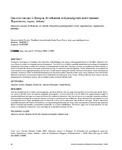Mostrar o rexistro simple do ítem
Giacomo Lercaro in Bologna: an Influential and Paradigmatic Event between Experiences, Hopes, Defeats
| dc.contributor.author | Comiati, Gaetano Adolfo | |
| dc.date.accessioned | 2020-10-02T08:36:22Z | |
| dc.date.available | 2020-10-02T08:36:22Z | |
| dc.date.issued | 2020 | |
| dc.identifier.citation | Comiati, Gaetano Adolfo. 2020. «Giacomo Lercaro in Bologna. An influential and paradigmatic event between ‘Experiences, hopes, defeats’». Actas de Arquitectura Religiosa Contemporánea 7: 52-63. https://doi.org/10.17979/ aarc.2020.7.0.6290. | es_ES |
| dc.identifier.issn | 2659-8671 | |
| dc.identifier.uri | http://hdl.handle.net/2183/26296 | |
| dc.description.abstract | [Abstract] Facing the emergency of building new churches, while Bologna was living a demographic boom in the fifties, Giacomo Lercaro chose to create an integrate system of progress. The ritual form of faith is spatially determined according to the physical peculiarity of the place in which the salvation is celebrated by Familia Dei. This form invokes an aesthetic-symbolic quality, in order to enable the delivery of human and social poverty in coherence with the Mystery. These experiences accompany the hard research of an appropriate place for the form of faith and an adequate faith for the form of the place. Given the absolute symbolic relevance of the ecclesiastical building and the performative capacity of the ritual, every research and intervention depend to personal and pastoral requirement rooted into extra-liturgical area. In fact, fiddling with the ritual means not only tampering the celebratory quality, but reconfiguring the ecclesial identity itself. | es_ES |
| dc.description.abstract | [Resumen] Ante la emergencia de construir nuevas iglesias, mientras Bolonia vivía un auge demográfico en los años cincuenta, Giacomo Lercaro decidió crear un sistema integrado de progreso. La forma ritual de la fe se determina espacialmente según la peculiaridad física del lugar en el que la Familia Dei celebra la salvación. Esta forma invoca una cualidad simbólico-estética, para permitir la entrega de la pobreza humana y social en coherencia con el Misterio. Estas experiencias acompañan la dura investigación de un lugar apropiado para la forma de la fe y una fe adecuada para la forma del lugar. Dada la relevancia simbólica absoluta del edificio eclesiástico y la capacidad performativa del ritual, toda investigación e intervención depende de los requisitos personales y pastorales arraigados en el área extralitúrgica. De hecho, jugar con el ritual significa no solo alterar la calidad de celebración, sino reconfigurar la identidad eclesial misma. | es_ES |
| dc.language.iso | eng | es_ES |
| dc.publisher | Universidade da Coruña | |
| dc.relation.uri | https://doi.org/10.17979/ aarc.2020.7.0.6290 | es_ES |
| dc.rights | Atribución-NoComercial-CompartirIgual 4.0 España | es_ES |
| dc.rights.uri | http://creativecommons.org/licenses/by-nc-sa/4.0/es/ | * |
| dc.subject | Giacomo Lercaro | es_ES |
| dc.subject | Bologna | es_ES |
| dc.subject | Familia Dei | es_ES |
| dc.subject | Actuosa participatio | es_ES |
| dc.subject | Choral history | es_ES |
| dc.subject | Bolonia | es_ES |
| dc.subject | Historia coral | es_ES |
| dc.title | Giacomo Lercaro in Bologna: an Influential and Paradigmatic Event between Experiences, Hopes, Defeats | es_ES |
| dc.title.alternative | Giacomo Lercaro en Bolonia: un evento influyente y paradigmático entre experiencias, esperanzas, derrotas | es_ES |
| dc.type | info:eu-repo/semantics/article | es_ES |
| dc.rights.access | info:eu-repo/semantics/openAccess | es_ES |
| UDC.journalTitle | Actas de Arquitectura Religiosa Contemporánea | es_ES |
| UDC.volume | 7 | es_ES |
| UDC.startPage | 52 | es_ES |
| UDC.endPage | 63 | es_ES |






